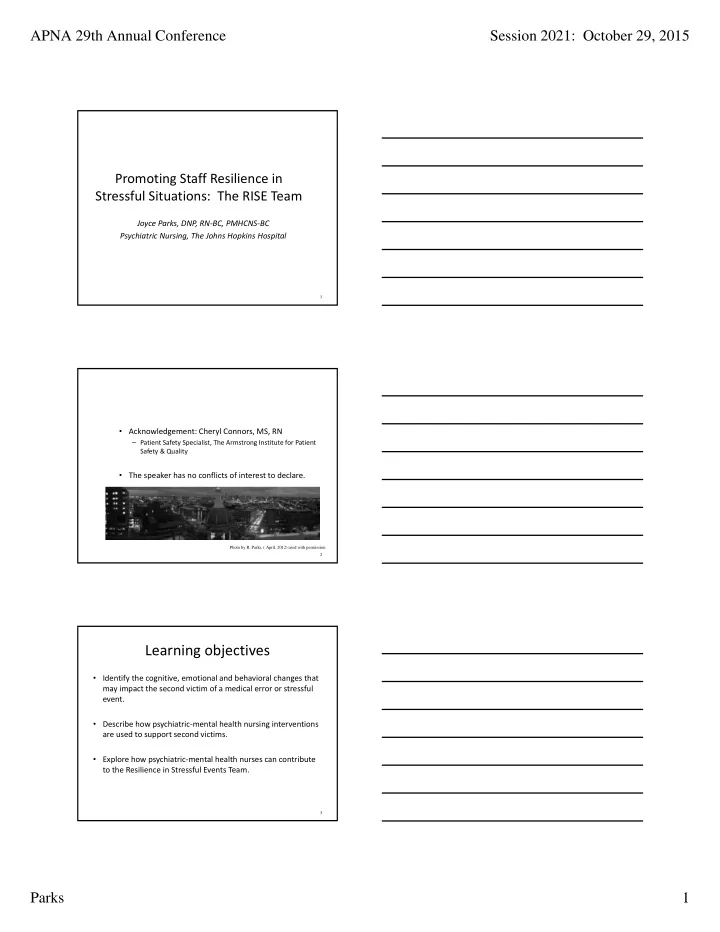

APNA 29th Annual Conference Session 2021: October 29, 2015 Promoting Staff Resilience in Stressful Situations: The RISE Team Joyce Parks, DNP, RN ‐ BC, PMHCNS ‐ BC Psychiatric Nursing, The Johns Hopkins Hospital 1 • Acknowledgement: Cheryl Connors, MS, RN – Patient Safety Specialist, The Armstrong Institute for Patient Safety & Quality • The speaker has no conflicts of interest to declare. Photo by R. Parks, ( April, 2012) used with permission 2 Learning objectives • Identify the cognitive, emotional and behavioral changes that may impact the second victim of a medical error or stressful event. • Describe how psychiatric ‐ mental health nursing interventions are used to support second victims. • Explore how psychiatric ‐ mental health nurses can contribute to the Resilience in Stressful Events Team. 3 Parks 1
APNA 29th Annual Conference Session 2021: October 29, 2015 The RISE Team at Hopkins • Our mission: – To provide timely support to staff from a peer after a stressful, patient ‐ related event. • Outcomes – Safer environment of care for patients – Decreased caregiver burden Edrees, H. H., Paine, L. A., Feroli, R., & Wu, A. W. (2011) May, M. & Plews-Ogan, M. (2012) 4 Definitions • First victims – Patients and their families • Second victims – “A health care provider involved in an unanticipated adverse patient event, medical error, and/or a patient related–injury who become victimized in the sense that the provider is traumatized by the event.” • Third victims Scott, Hirschinger, Cox, McCoig, Brant, J. & Hall (2009). p. 326 Wu, (2000) Mira et al., (2015) 5 Stages of Recovery Moving Obtaining On Emotional 1 st Aid Enduring the inquisition Restore Personal Integrity Intrusive Reflections Chaos - Accident Response Event Adapted from Scott, et al., (2009) 6 Parks 2
APNA 29th Annual Conference Session 2021: October 29, 2015 Stage 6: Moving On Dropping Out Surviving Thriving Transfer/Leave Coping but with persistent Maintains work/life intrusive thoughts and balance; sadness; still trying to learn Gains insights; from the event. Advocates for change resulting in safer care. “Can I handle this type of “How could I have ‘What can I learn from work?” prevented this from this?’ happening?” ‘What can I do to make it “Why do I feel so bad, so better?” guilty?” Scott, et al. ,(2009) Ullström, Sachs, Hansson, Øvretveit, & Brommels, (2013) Grissinger, (2014) 7 Types of calls • Unexpected patient related adverse event • Death of a staff member • Changing medical boundaries • Significant events including – Medical error – Ebola – Distress secondary to inappropriate communication after an event 8 Who Provides Support? Volunteer Peer Responders • People who work all over the organization – Nurses • Bedside clinicians, managers, advanced practice nurses, administrators – Physicians – Pharmacists – Social workers – Pastoral care – Respiratory therapists 9 Parks 3
APNA 29th Annual Conference Session 2021: October 29, 2015 What Does Support Look Like? THE CONTINUUM OF CARING PSYCHOLOGICAL CRISIS COUNSELING PSYCHIATRIC CARE FIRST AID INTERVENTION WITH MEDICATIONS AND THERAPY PHYSICAL FIRST AID BASIC LIFE ADVANCED LIFE MEDICAL SUPPORT SUPPORT SURGICAL INTERVENTION Pekevski, (2013) 10 Psychological First Aid • The goal : immediate, targeted support – R eflective Listening – A ssessment of Needs – P rioritization – I ntervention • Grounding, support, activation of resources – D isposition Johns Hopkins Center for Public Health Preparedness (2015) Everly. McCabe , Semon, Thompson & Links (2014) Najavits, (2002) 11 Grounding • Grounding is a simple set of strategies that may be done anytime or anywhere – May decrease anxiety, cravings, self ‐ harming behavior or low mood • Mental grounding techniques • Physical grounding techniques • Self ‐ soothing grounding techniques Najavits, (2002) 12 Parks 4
APNA 29th Annual Conference Session 2021: October 29, 2015 Bumps in the road • The first 18 months there were 18 calls for peer support – RISE was piloted for 12 months in the department of Pediatrics; 1 call/month – The next 6 months, RISE was available to the organization; 1 call/month • What were the barriers to using the RISE team? Scott, et al., (2010) 13 Focus Groups with Key Stakeholders in the Organization • Bedside nurses • Respiratory therapy • House staff – Introduce the RISE team – What type of support is most desired? – Do you know the process for reaching a RISE peer responder? – How quickly do you desire a response? – What would prevent you from contacting RISE ? 14 What services are not offered • Peer support is not psychotherapy. • Peer support is not an investigation of an adverse event. • There is no report to the supervisor. 15 Parks 5
APNA 29th Annual Conference Session 2021: October 29, 2015 Services Offered • Confidential, non ‐ judgmental, peer to peer support available for individuals or groups • Available 24/7 within a 30 minute response time 16 Contributions of PMH Nurses To the RISE team To the organization • Change to offering group • Culture change to promote de ‐ briefing services in open dialogue after a addition to individual stressful event support after events • Assisted team leaders with ongoing training for current peer responders White, et al., (2015 Hart, Brannan, & de Chesney (2012) 17 Number of calls People supported: > 200 3 ‐ 4 calls each month (73) • Next 18 1call /month months (18) • First 18 months 18 Parks 6
APNA 29th Annual Conference Session 2021: October 29, 2015 Future directions • Disseminate RISE to other organizations – Within our enterprise – Within our community • Research 19 Questions jparks @jhmi.edu 20 Parks 7
Recommend
More recommend